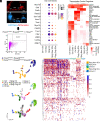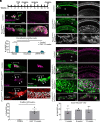Expression of Atoh1, Gfi1, and Pou4f3 in the mature cochlea reprograms nonsensory cells into hair cells
- PMID: 38266052
- PMCID: PMC10835112
- DOI: 10.1073/pnas.2304680121
Expression of Atoh1, Gfi1, and Pou4f3 in the mature cochlea reprograms nonsensory cells into hair cells
Abstract
Mechanosensory hair cells of the mature mammalian organ of Corti do not regenerate; consequently, loss of hair cells leads to permanent hearing loss. Although nonmammalian vertebrates can regenerate hair cells from neighboring supporting cells, many humans with severe hearing loss lack both hair cells and supporting cells, with the organ of Corti being replaced by a flat epithelium of nonsensory cells. To determine whether the mature cochlea can produce hair cells in vivo, we reprogrammed nonsensory cells adjacent to the organ of Corti with three hair cell transcription factors: Gfi1, Atoh1, and Pou4f3. We generated numerous hair cell-like cells in nonsensory regions of the cochlea and new hair cells continued to be added over a period of 9 wk. Significantly, cells adjacent to reprogrammed hair cells expressed markers of supporting cells, suggesting that transcription factor reprogramming of nonsensory cochlear cells in adult animals can generate mosaics of sensory cells like those seen in the organ of Corti. Generating such sensory mosaics by reprogramming may represent a potential strategy for hearing restoration in humans.
Keywords: cochlea; hair cells; inner ear; reprogramming.
Conflict of interest statement
Competing interests statement:The authors declare no competing interest.
Figures





Similar articles
-
Reprogramming with Atoh1, Gfi1, and Pou4f3 promotes hair cell regeneration in the adult organ of Corti.PNAS Nexus. 2024 Oct 4;3(10):pgae445. doi: 10.1093/pnasnexus/pgae445. eCollection 2024 Oct. PNAS Nexus. 2024. PMID: 39411090 Free PMC article.
-
Combinatorial Atoh1 and Gfi1 induction enhances hair cell regeneration in the adult cochlea.Sci Rep. 2020 Dec 8;10(1):21397. doi: 10.1038/s41598-020-78167-8. Sci Rep. 2020. PMID: 33293609 Free PMC article.
-
Cellular reprogramming with ATOH1, GFI1, and POU4F3 implicate epigenetic changes and cell-cell signaling as obstacles to hair cell regeneration in mature mammals.Elife. 2022 Nov 29;11:e79712. doi: 10.7554/eLife.79712. Elife. 2022. PMID: 36445327 Free PMC article.
-
Atoh1 and other related key regulators in the development of auditory sensory epithelium in the mammalian inner ear: function and interplay.Dev Biol. 2019 Feb 15;446(2):133-141. doi: 10.1016/j.ydbio.2018.12.025. Epub 2018 Dec 31. Dev Biol. 2019. PMID: 30605626 Review.
-
Atoh1 gene therapy in the cochlea for hair cell regeneration.Expert Opin Biol Ther. 2015 Mar;15(3):417-30. doi: 10.1517/14712598.2015.1009889. Epub 2015 Feb 3. Expert Opin Biol Ther. 2015. PMID: 25648190 Review.
Cited by
-
Temporally-segregated dual functions for Gfi1 in the development of retinal direction-selectivity.bioRxiv [Preprint]. 2025 Jun 6:2025.06.03.657700. doi: 10.1101/2025.06.03.657700. bioRxiv. 2025. PMID: 40502160 Free PMC article. Preprint.
-
EDNRB2 regulates fate, migration, and maturation of hair cell precursors in regenerating avian auditory epithelium explants.Proc Natl Acad Sci U S A. 2025 Jul 15;122(28):e2502713122. doi: 10.1073/pnas.2502713122. Epub 2025 Jul 8. Proc Natl Acad Sci U S A. 2025. PMID: 40627393
-
Molecular Cascades That Build and Connect Auditory Neurons from Hair Cells to the Auditory Cortex.J Exp Neurol. 2025;6(3):111-120. J Exp Neurol. 2025. PMID: 40823538 Free PMC article.
-
Conditional Overexpression of Serpine2 Promotes Hair Cell Regeneration from Lgr5+ Progenitors in the Neonatal Mouse Cochlea.Adv Sci (Weinh). 2025 May;12(18):e2412653. doi: 10.1002/advs.202412653. Epub 2025 Mar 17. Adv Sci (Weinh). 2025. PMID: 40091489 Free PMC article.
-
AAV-mediated Gene Cocktails Enhance Supporting Cell Reprogramming and Hair Cell Regeneration.Adv Sci (Weinh). 2024 Aug;11(29):e2304551. doi: 10.1002/advs.202304551. Epub 2024 May 29. Adv Sci (Weinh). 2024. PMID: 38810137 Free PMC article.
References
-
- Henley C. M., Rybak L. P., Ototoxicity in developing mammals. Brain Res. Rev. 20, 68–90 (1995). - PubMed
MeSH terms
Substances
Grants and funding
LinkOut - more resources
Full Text Sources
Medical
Molecular Biology Databases

